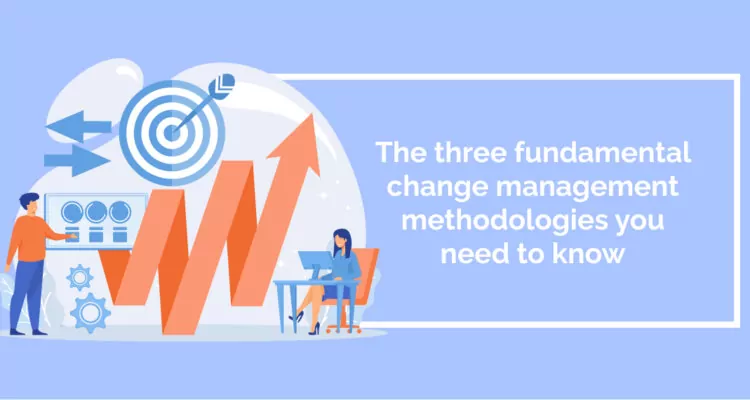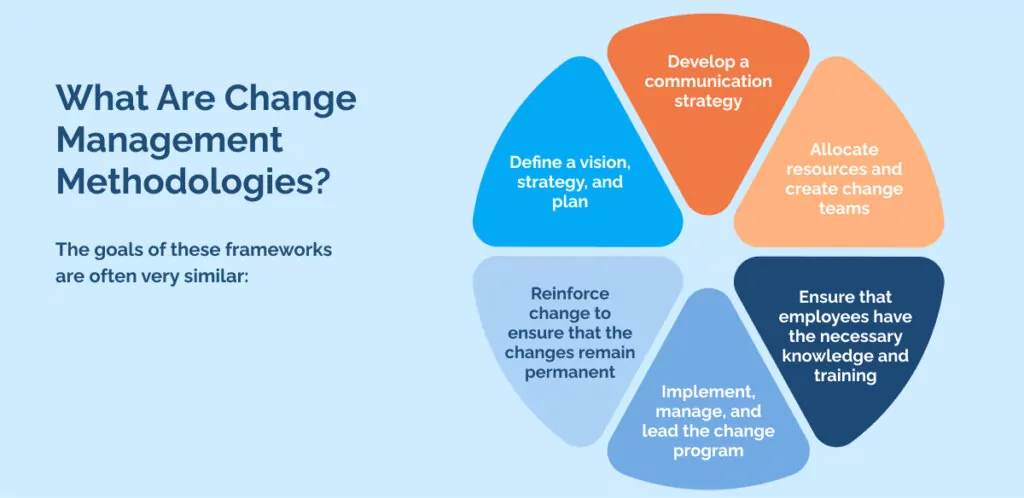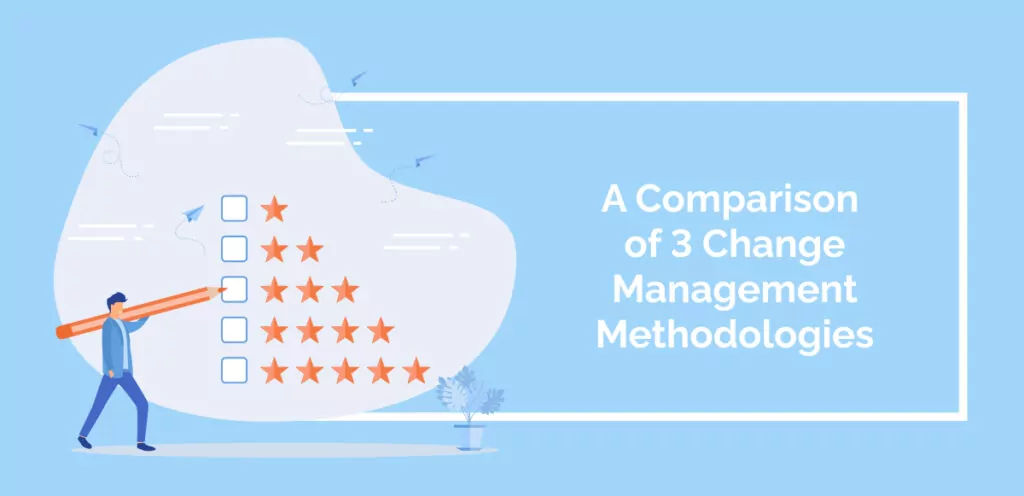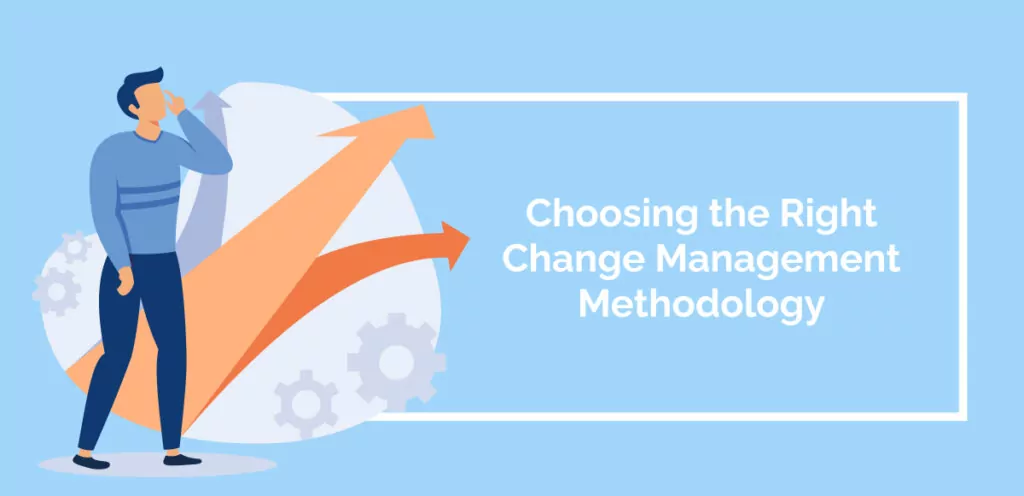
Change management methodologies provide a framework to efficiently implement organizational change. Experienced change practitioners produce change management methodologies based on common patterns in change projects.
A change management methodology helps you deliver several bottom-line benefits of change projects. That could mean better project outcomes, decreased employee resistance, and shortened project timelines. So there are many good reasons for understanding these models before starting a change project.
This article will introduce the major components of change management models and examine three particular models in detail. We will:
- Carefully define the meaning of a change management methodologies;
- Introduce the ProSci, Kotter, and ACMP models;
- Suggest some key questions for how to choose your methodology.
Along the way, we will signpost further research and reading that can help you achieve a complete understanding.
What Are Change Management Methodologies?

Change management is the discipline dedicated to designing, managing, and leading organizational change. A change management methodology helps leaders prepare, implement, and evaluate a change’s impact on a company’s performance. The methodology provides a practical framework, or roadmap, which outlines a set of actions to follow.
The goals of these frameworks are often very similar:
- Define a vision, strategy, and plan
- Develop a communication strategy
- Allocate resources and create change teams
- Ensure that employees have the necessary knowledge and training
- Implement, manage, and lead the change program
- Reinforce change to ensure that the changes remain permanent
However, the biggest challenges in a change project will differ for every company. The challenges of change can depend on organizational structure; the industry; geographic location; culture; and much more. That’s why many change management methodologies have been created. Fortunately, this choice of methods based on change management research helps change leaders decide the best approach for their company.
Some change management models are based on strong leadership, others prioritize consensus among organizational staff, and some have special relevance for technologies.
- Kotter’s 8-Step Process for Leading Change
- Lewin’s Change Management Model
- The Lippit-Knoster model for complex change
- Bridges’ Transition Model
- McKinsey 7 Ss Model for organizational transformation
- ITIL change management methods
- Satir Change Model
- Agile change management
We won’t discuss these change management models in this article – after all, we’ve got special posts on many of them (just click the links in the list!). But to get some insight into how different models shape up, we will compare three prominent methods in the next section.
A Comparison of 3 Change Management Methodologies

This section will dive deeper into the important change management models. From all the valuable models on our list, we will look at:
- Prosci’s model for the “human element” of change;
- Kotter’s 8-step model;
- ACMP’s Standard for change management.
You might find that one of these models is perfect for your current organizational challenges, But even if they don’t fit, you can learn a great deal by studying them. A good change practitioner will always adapt their models to achieve successful change.
Prosci’s Methodology
Prosci’s change method takes two approaches: individual change and organizational change.
The ADKAR framework, their roadmap for implementing change at the individual level, consists of five stages:
- Create awareness of the need for change
- Cultivate a desire to support the change
- Provide teams with the knowledge of how to change
- Ensure employees can demonstrate the ability to implement required skills and behaviors
- Reinforce the change to ensure that it sticks
This model is used in conjunction with a three-phase process for organizational change:
- Prepare for change by defining the change management strategy, preparing the change management team, and developing the sponsorship model
- Manage change by developing change management plans, then taking action and implementing those plans
- Reinforce change by collecting and analyzing feedback, identifying gaps, managing resistance, implementing corrective actions, and celebrating successes.
For Prosci, linking individual and organizational change management distinguishes their method from other methodologies.
Kotter’s 8-Step Model
Dr. John Kotter’s 8-step model for change presents a straightforward process that managers and business leaders can follow when pursuing a new change initiative.
These steps include:
- Create a sense of urgency
- Build a guiding coalition
- Form a strategic vision and initiatives
- Enlist a volunteer army
- Enable action by removing barriers
- Generate short-term wins
- Sustain acceleration
- Institute change
This model aligns with Prosci’s ADKAR model in many respects since it emphasizes the need for guiding and engaging employees.
However, it also includes elements that focus on the organizational side of change, such as forming a strategy.
ACMP’s Standard for Change Management
ACMP’s Standard for Change Management is a comprehensive and detailed methodology developed by the Association of Change Management Professionals.
Their process includes five steps:
- Evaluate change impact and organizational readiness
- Formulate the change management strategy
- Develop the change management plan
- Execute the change management plan
- Complete the change management effort
These five steps, in turn, consist of many other smaller steps and activities that overlap with many of the activities covered in the two methods outlined above.
Professionals wishing to learn and apply this system can obtain training through qualified providers or certification from the ACMP directly.
Choosing the Right Change Management Methodology

Selecting the right change management methodology is a pivotal decision with profound implications for an organization. The methods chosen shape how successfully and smoothly the change initiative is embraced by stakeholders. It directly influences whether goals are met or missed, resources are optimally utilized or wasted, and resistance is minimized or amplified.
To help you in your journey for a change methodology, here’s a long list of key questions you can explore:
- What is the nature of the change?
- What are the organizational goals and objectives?
- What is the corporate culture?
- What is the level of stakeholder involvement?
- What is the timeline for implementation?
- What resources are available?
- What is the level of risk tolerance?
- What communication and engagement strategies are needed?
- Is agile or iterative implementation desired?
- Is individual behavior change important?
- What does success look like?
- Is external expertise required?
More deeply, you will need to think about who will manage the change, what those managers’ preferences are, and how much experience they have in change management. Likewise, you’ll need to consider the preferences of staff and leaders and the alignment between a change methodology and the organization’s culture.
Although the popular change models have a track record of success, positive outcomes will often depend on the capabilities of a change leader. For instance, a change practitioner who has experience in one method will be better prepared to use that method in a new environment. They can understand the strengths of the model (and its weaknesses) and better prepare for organizational success.
At the start of their change journey, companies should allow some time to dig deeper into the various methodologies. Building an enterprise change management function is no mean feat – so listen to the guidance of people who’ve gone before.
Change Management Methodologies: What Next?
To wrap up this article, let’s finish with a simple thought.
A change management method is a “must-have” for organizational change. Organizations use a comprehensive change management process – because they know it is a very useful and effective way to get change right. It helps you to avoid poor planning and to get a positive response from stakeholders.
Of course, it’s hard to make decisions about the right method. There are many examples from the history of change management (as we have seen).
Remember that change management, like any organizational discipline, is always developing. For example, even though McKinsey has a very popular change management model (the 7 Ss), they continually show that successful transformations must adapt to the present moment.
To learn more, keep up with the latest research, read our change management articles, and think carefully about your strategic vision.
WalkMe Team
WalkMe spearheaded the Digital Adoption Platform (DAP) for associations to use the maximum capacity of their advanced resources. Utilizing man-made consciousness, AI, and context-oriented direction, WalkMe adds a powerful UI layer to raise the computerized proficiency, everything being equal.



